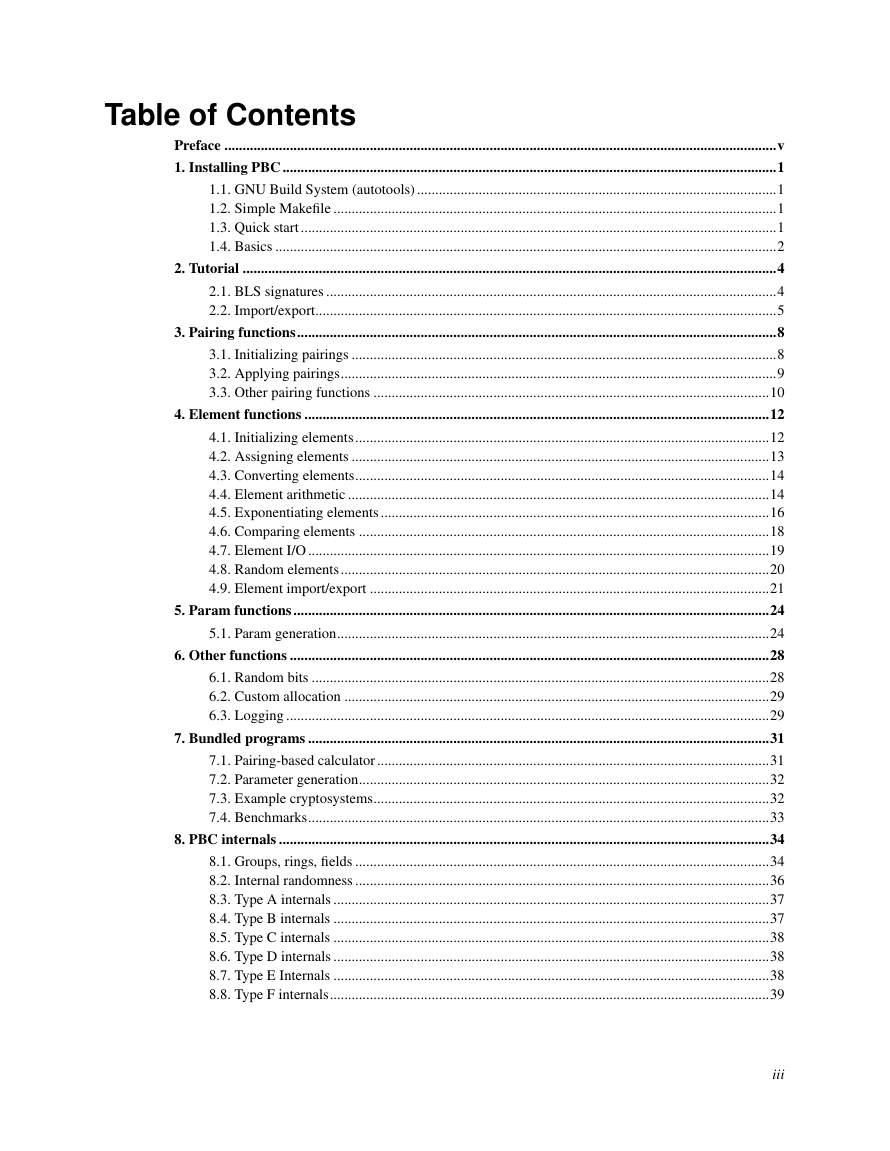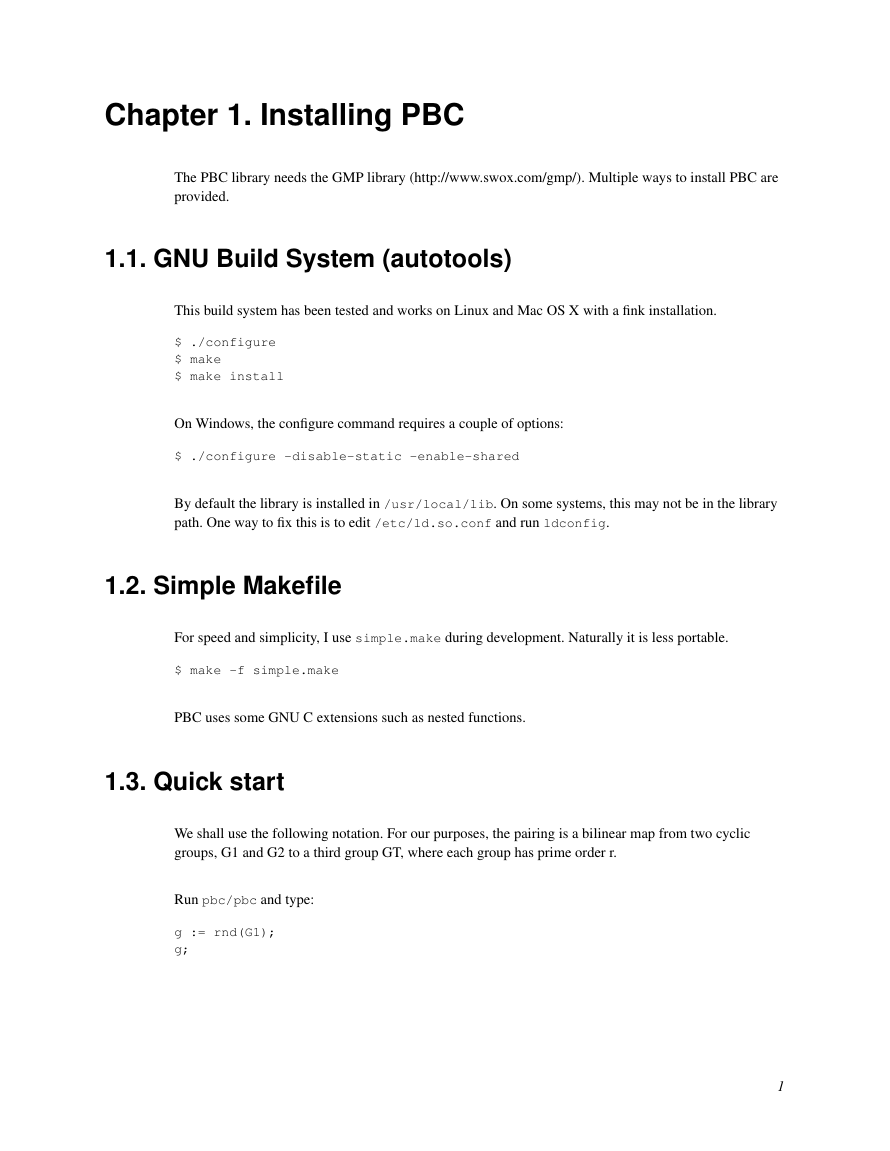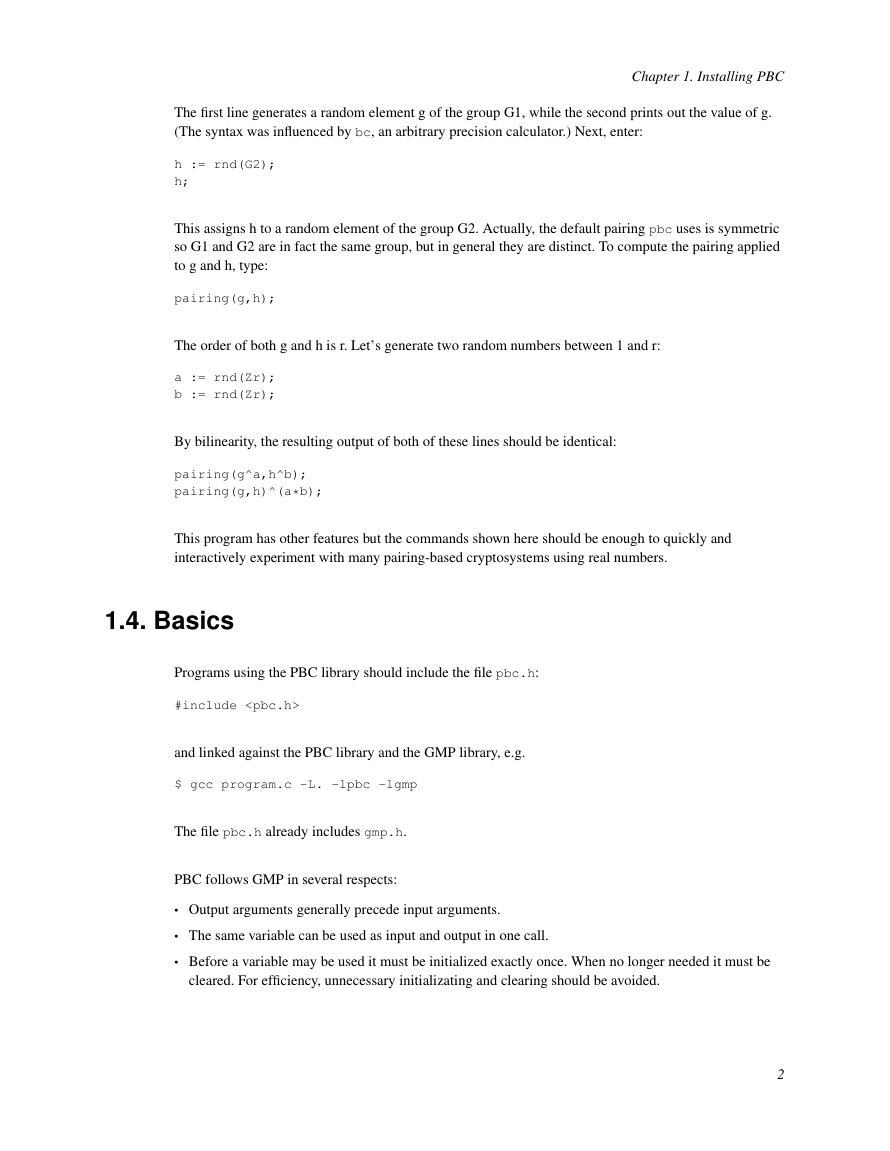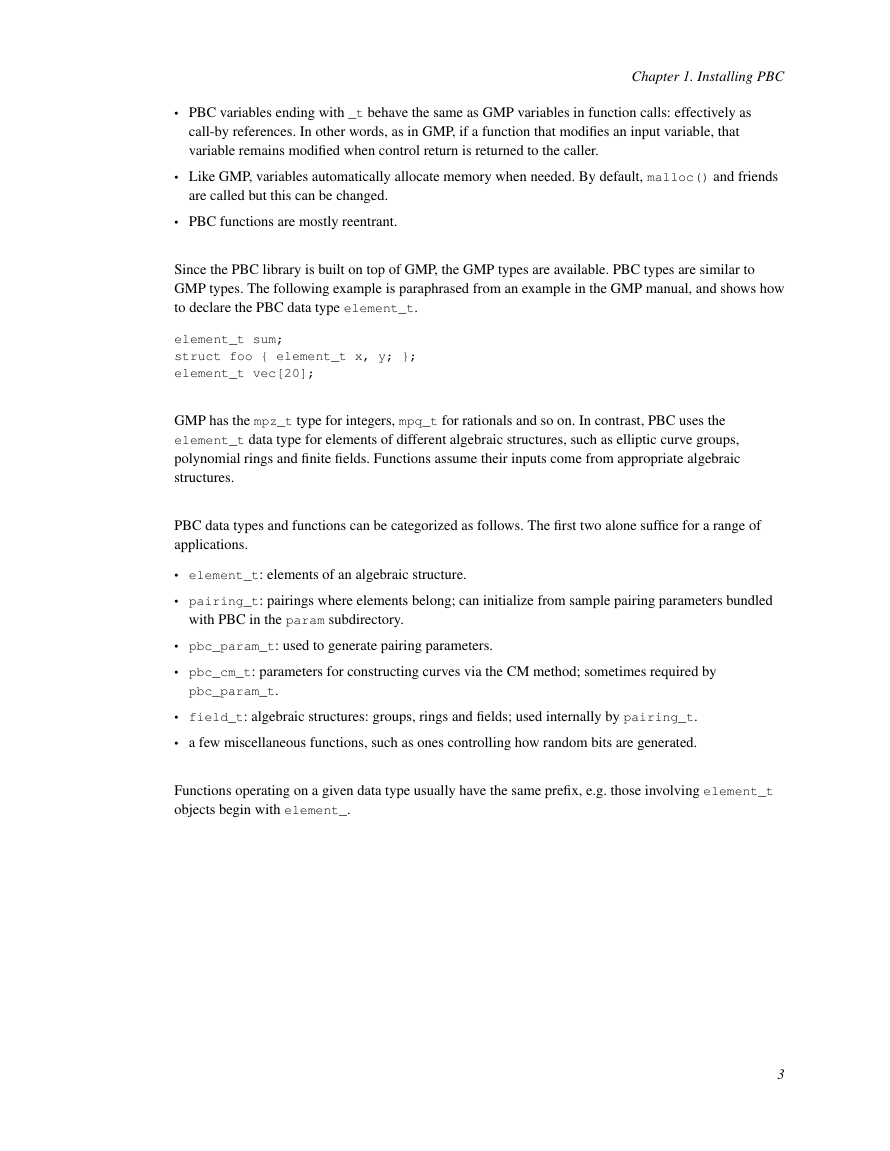PBC Library Manual 0.5.11
Ben Lynn
�
PBC Library Manual 0.5.11
by Ben Lynn
Revision History
2006 Revised by: BL
�
Table of Contents
Preface ........................................................................................................................................................v
1. Installing PBC ........................................................................................................................................1
1.1. GNU Build System (autotools) ...................................................................................................1
1.2. Simple Makefile ..........................................................................................................................1
1.3. Quick start ...................................................................................................................................1
1.4. Basics ..........................................................................................................................................2
2. Tutorial ...................................................................................................................................................4
2.1. BLS signatures ............................................................................................................................4
2.2. Import/export...............................................................................................................................5
3. Pairing functions....................................................................................................................................8
3.1. Initializing pairings .....................................................................................................................8
3.2. Applying pairings........................................................................................................................9
3.3. Other pairing functions .............................................................................................................10
4. Element functions ................................................................................................................................12
4.1. Initializing elements..................................................................................................................12
4.2. Assigning elements ...................................................................................................................13
4.3. Converting elements..................................................................................................................14
4.4. Element arithmetic ....................................................................................................................14
4.5. Exponentiating elements ...........................................................................................................16
4.6. Comparing elements .................................................................................................................18
4.7. Element I/O ...............................................................................................................................19
4.8. Random elements......................................................................................................................20
4.9. Element import/export ..............................................................................................................21
5. Param functions...................................................................................................................................24
5.1. Param generation.......................................................................................................................24
6. Other functions ....................................................................................................................................28
6.1. Random bits ..............................................................................................................................28
6.2. Custom allocation .....................................................................................................................29
6.3. Logging .....................................................................................................................................29
7. Bundled programs ...............................................................................................................................31
7.1. Pairing-based calculator ............................................................................................................31
7.2. Parameter generation.................................................................................................................32
7.3. Example cryptosystems.............................................................................................................32
7.4. Benchmarks...............................................................................................................................33
8. PBC internals .......................................................................................................................................34
8.1. Groups, rings, fields ..................................................................................................................34
8.2. Internal randomness ..................................................................................................................36
8.3. Type A internals ........................................................................................................................37
8.4. Type B internals ........................................................................................................................37
8.5. Type C internals ........................................................................................................................38
8.6. Type D internals ........................................................................................................................38
8.7. Type E Internals ........................................................................................................................38
8.8. Type F internals.........................................................................................................................39
iii
�
8.9. Type G Internals........................................................................................................................40
8.10. Testing functions .....................................................................................................................40
8.11. Dynamic arrays .......................................................................................................................41
8.12. Symbol tables..........................................................................................................................42
8.13. Religious stances.....................................................................................................................43
9. Security issues ......................................................................................................................................45
A. Contributors ........................................................................................................................................46
iv
�
Preface
The PBC library is a free portable C library allowing the rapid prototyping of pairing-based
cryptosystems. It provides an abstract interface to a cyclic group with a bilinear pairing, insulating the
programmer from mathematical details. Knowledge of elliptic curves is optional.
The PBC library is built on top of the GMP library, and the PBC API is strongly influenced by the GMP
API. Accordingly, this manual tries to imitate the look and feel of the GMP manual.
The PBC library homepage: http://crypto.stanford.edu/pbc/
The GMP library homepage: http://www.swox.com/gmp/
v
�
Chapter 1. Installing PBC
The PBC library needs the GMP library (http://www.swox.com/gmp/). Multiple ways to install PBC are
provided.
1.1. GNU Build System (autotools)
This build system has been tested and works on Linux and Mac OS X with a fink installation.
$ ./configure
$ make
$ make install
On Windows, the configure command requires a couple of options:
$ ./configure -disable-static -enable-shared
By default the library is installed in /usr/local/lib. On some systems, this may not be in the library
path. One way to fix this is to edit /etc/ld.so.conf and run ldconfig.
1.2. Simple Makefile
For speed and simplicity, I use simple.make during development. Naturally it is less portable.
$ make -f simple.make
PBC uses some GNU C extensions such as nested functions.
1.3. Quick start
We shall use the following notation. For our purposes, the pairing is a bilinear map from two cyclic
groups, G1 and G2 to a third group GT, where each group has prime order r.
Run pbc/pbc and type:
g := rnd(G1);
g;
1
�
The first line generates a random element g of the group G1, while the second prints out the value of g.
(The syntax was influenced by bc, an arbitrary precision calculator.) Next, enter:
Chapter 1. Installing PBC
h := rnd(G2);
h;
This assigns h to a random element of the group G2. Actually, the default pairing pbc uses is symmetric
so G1 and G2 are in fact the same group, but in general they are distinct. To compute the pairing applied
to g and h, type:
pairing(g,h);
The order of both g and h is r. Let’s generate two random numbers between 1 and r:
a := rnd(Zr);
b := rnd(Zr);
By bilinearity, the resulting output of both of these lines should be identical:
pairing(g^a,h^b);
pairing(g,h)^(a*b);
This program has other features but the commands shown here should be enough to quickly and
interactively experiment with many pairing-based cryptosystems using real numbers.
1.4. Basics
Programs using the PBC library should include the file pbc.h:
#include
and linked against the PBC library and the GMP library, e.g.
$ gcc program.c -L. -lpbc -lgmp
The file pbc.h already includes gmp.h.
PBC follows GMP in several respects:
• Output arguments generally precede input arguments.
• The same variable can be used as input and output in one call.
• Before a variable may be used it must be initialized exactly once. When no longer needed it must be
cleared. For efficiency, unnecessary initializating and clearing should be avoided.
2
�Chapter 1. Installing PBC
• PBC variables ending with _t behave the same as GMP variables in function calls: effectively as
call-by references. In other words, as in GMP, if a function that modifies an input variable, that
variable remains modified when control return is returned to the caller.
• Like GMP, variables automatically allocate memory when needed. By default, malloc() and friends
are called but this can be changed.
• PBC functions are mostly reentrant.
Since the PBC library is built on top of GMP, the GMP types are available. PBC types are similar to
GMP types. The following example is paraphrased from an example in the GMP manual, and shows how
to declare the PBC data type element_t.
element_t sum;
struct foo { element_t x, y; };
element_t vec[20];
GMP has the mpz_t type for integers, mpq_t for rationals and so on. In contrast, PBC uses the
element_t data type for elements of different algebraic structures, such as elliptic curve groups,
polynomial rings and finite fields. Functions assume their inputs come from appropriate algebraic
structures.
PBC data types and functions can be categorized as follows. The first two alone suffice for a range of
applications.
• element_t: elements of an algebraic structure.
• pairing_t: pairings where elements belong; can initialize from sample pairing parameters bundled
with PBC in the param subdirectory.
• pbc_param_t: used to generate pairing parameters.
• pbc_cm_t: parameters for constructing curves via the CM method; sometimes required by
pbc_param_t.
• field_t: algebraic structures: groups, rings and fields; used internally by pairing_t.
• a few miscellaneous functions, such as ones controlling how random bits are generated.
Functions operating on a given data type usually have the same prefix, e.g. those involving element_t
objects begin with element_.
3
�
















 2023年江西萍乡中考道德与法治真题及答案.doc
2023年江西萍乡中考道德与法治真题及答案.doc 2012年重庆南川中考生物真题及答案.doc
2012年重庆南川中考生物真题及答案.doc 2013年江西师范大学地理学综合及文艺理论基础考研真题.doc
2013年江西师范大学地理学综合及文艺理论基础考研真题.doc 2020年四川甘孜小升初语文真题及答案I卷.doc
2020年四川甘孜小升初语文真题及答案I卷.doc 2020年注册岩土工程师专业基础考试真题及答案.doc
2020年注册岩土工程师专业基础考试真题及答案.doc 2023-2024学年福建省厦门市九年级上学期数学月考试题及答案.doc
2023-2024学年福建省厦门市九年级上学期数学月考试题及答案.doc 2021-2022学年辽宁省沈阳市大东区九年级上学期语文期末试题及答案.doc
2021-2022学年辽宁省沈阳市大东区九年级上学期语文期末试题及答案.doc 2022-2023学年北京东城区初三第一学期物理期末试卷及答案.doc
2022-2023学年北京东城区初三第一学期物理期末试卷及答案.doc 2018上半年江西教师资格初中地理学科知识与教学能力真题及答案.doc
2018上半年江西教师资格初中地理学科知识与教学能力真题及答案.doc 2012年河北国家公务员申论考试真题及答案-省级.doc
2012年河北国家公务员申论考试真题及答案-省级.doc 2020-2021学年江苏省扬州市江都区邵樊片九年级上学期数学第一次质量检测试题及答案.doc
2020-2021学年江苏省扬州市江都区邵樊片九年级上学期数学第一次质量检测试题及答案.doc 2022下半年黑龙江教师资格证中学综合素质真题及答案.doc
2022下半年黑龙江教师资格证中学综合素质真题及答案.doc